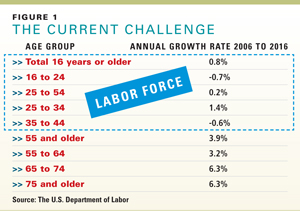Recruiting and Retaining Top Talent: Cheryl Perkins, InnovationEdge
 More and more companies are facing talent management challenges. Downsizing, the aging of the workforce and the ongoing retirement of resources with years of institutional knowledge are making it even harder for them to have the right people, with the right skills, in the right place to deliver growth and innovation.
More and more companies are facing talent management challenges. Downsizing, the aging of the workforce and the ongoing retirement of resources with years of institutional knowledge are making it even harder for them to have the right people, with the right skills, in the right place to deliver growth and innovation.
There is an urgent need today to improve workforce productivity, retain high performers and weed out remaining low performers. However at the same time, many organizations are also faced with a younger workforce as experienced baby boomers retire and the number of middle-aged workers decline (See Figure 1). These generational trends are making an impact on how companies recruit and retain the staff they need to remain competitive and innovative.
The new workforce generation is not only changing due to size, but their shifting values are also affecting the ability to attract and retain them. Today's young to middle-aged employees seek:
- A healthy life/work balance
- A company with a strong brand and reputation
- Frequent recognition and quick growth within a company
Not surprisingly, a recent Deloitte survey found that, regardless of business size or industry, significant challenges today included the shortage, motivation and retention of qualified talent. Businesses of all types are impacted by the different priorities of a younger workforce. To deal with these new realities and because of increasing pressure to reduce central human resources investments, many companies are going back to basics and refocusing on improving the talent management effectiveness of their leaders.
 This makes sense, but is not a simple task! Many mangers today are so busy with the day-to-day functioning of their operations that they have little time to think strategically about their talent management efforts.
This makes sense, but is not a simple task! Many mangers today are so busy with the day-to-day functioning of their operations that they have little time to think strategically about their talent management efforts.
Here are some common sense tips leaders should keep in mind as they manage and develop workforce talent:
- Look at the people within the organization and make sure everyone throughout the company understands clearly and is aligned with the business strategy.
- Hire people that integrate well with company culture and that complement skill sets and values. Look for candidates demonstrating optimism and passion, energy and creativity.
- Remember that generous pay is no longer sufficient to attract and hold on to the best talent. Company environment, brand and reputation can be just as important.
- Identify the skills that the organization needs for the longer term (three years or more). Acquire, develop and grow talent using these skills as a guide.
- Provide ample opportunities for diverse employee experiences in role or in location.
- Don't wait until talent retires or leaves the company to find out how valuable work experience and human intellectual assets are.
Continuously transition that knowledge. This can be done both formally through mechanisms like internal conferences or mentoring programs, or informally for example through the encouragement of employee networking and education mechanisms like non-mandatory lunch seminars.
While some baby boomers are still left in the workforce, now is the time to put a plan together about your future talent. Companies that strategically recruit, train and retain their key players will see the most impact on company growth and performance.
For more information about how leaders can effectively manage talent, e-mail the author at [email protected].
